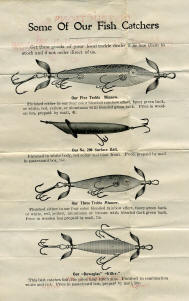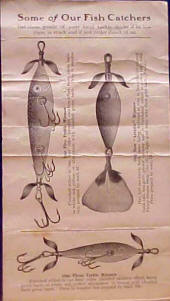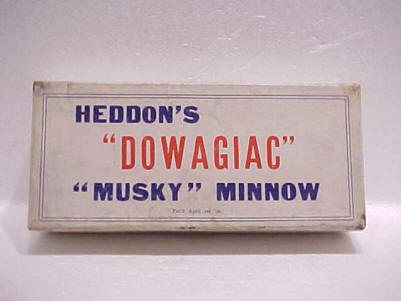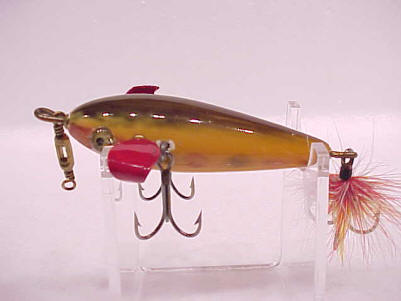AntiqueLures |
How, Why, and What We Collect in Antique Lures
By Dr. Michael Echols
How do you go about deciding what to collect and why Icollect in only certain areas? First, let me explain that I have and do collect in several areas. For fifteen years, I collected museum grade antique lever action Winchester rifles. I no longer collect guns for various reasons, but I learned to grade, trade, study, and think and study 'collectible' with the guns. I also collected gold coins and learned about being extremely picky and how to spot fakes. I know how to study and use data. I know how to learn about a topic which interests me and when I decide to do something, it's a case of all or nothing...witness this Web site!
Collecting on a large scale requires understanding financial markets. If you don't, you go broke fast. I think I understand something about investing and what makes markets. I collect collectibles because I really enjoy it, love the history, and enjoy the travel to meet people who share my interests, but I always have to make the decision when I buy: is this a good investment? Otherwise it becomes both a time and financial killing activity. Both have limits if you have a life.
What I do personally:
If I sit down with a copy of Luckey's or Edmisten and Murphy's book, I can highlight specific lures I want or like, and it really isn't a long list when I finish. If I do the same with Kimball's book on early lures, then the list gets really awesome and overwhelming. I find this exercise gives me direction so I don't just buy to be buying. Much of my taste is influenced by other collections or auctions. I have tried to plan my collection around pre-1940 underwater minnows and body shape like the Heddon 150, but I do branch into other areas. I have a very clear plan about what I want to buy and what I don't want to pay for any given item. I do not buy anything without thoroughly researching it. I also don't buy or collect post 1940 lures because, like other things in America, post war production processes were much less quality oriented and the volume was so great their availability precludes rarity being a factor.
Before you do anything like buying expensive lures or boxes, you need books. At a minimum, you need Luckey's, Edmisten and Murphy's, White's, Pavey's, and without question...Kimball's for early lures. None of these books will help much with pricing other than to buy in the field. You have to watch and log sales on eBay to keep up with the current prices. It used to be that you could just watch auction results to get an idea on high-end material, but that source has pretty much dried up. What I do now is track sales on eBay of things I collect, print out the sale page with the final price and put it in a note book. Most of us used to use sales lists to track prices, but those have gone the way of the dodo bird due to the Internet and eBay.
I like early miscellaneous and Shakespeare because these are the really rare areas to collect and not many people understand either camp. (Knowledge is power. ) I greatly appreciate Heddon lures and boxes because of the quality, diversity, and age, but for really tough pieces, I prefer pre-1920 Heddon, Shakespeare, and certain miscellaneous companies. Rhodes is a particular favorite too, but so hard to accumulate that it leaves you thirsty. Better to collect something you can actually find than spend your life looking.
I collect boxes and paper because that is where the pieces of the puzzle fall apart or come together the fastest. The paper didn't survive and it's the key to understanding when the lure was made, the numbers, and to document correct shapes or colors. Paper is the link to the history. Paper is the trail to research.
I don't color collect lures because people will stick it to you if they know you need a certain or rare color for your collection. It just never appealed to me for someone to direct which pieces I needed to put in my collection based on what they thought was rare or one of a kind, so I don't color collect. It saves on the dollars too.
I avoid areas that are 'hot' because one or two collectors will drive up the price for a while, so I stay away until things settle down.
I always suggest any serious collector spend an enormous amount of time going through old issues of auction catalogs to see what was desirable and what the auction house thought was valuable. Over the years you can discern patterns and I try to trace the patterns and follow in their foot steps. Sometimes it pays to copy those who precede you. Pioneers get arrows in the chest for their efforts sometimes.
Don't buy anything unless it is a good investment. If no one else wants it, why would I? Yes, I buy things I like, but my tastes are typically along the same lines as those who are willing to pay high dollar figures and that is a good place to be if you ever intend to sell your collection. Collecting one-eyed pollywogs in chartreuse may be interesting, but unless someone is willing to take you out of it in the future, you better either buy it right or avoid it all together. Sooner or later most serious collectors will want to modify their collections or change direction and being able to trade or sell out of the items you don't want or need is a necessity to avoid being buried in something you can't move.
Let's talk for a minute about investing in collectibles. If you can afford the 'invest' in collectibles, you have disposable cash. If you look across the spectrum of collecting, lures are really cheap compared to other areas like rare books, watches, art, duck decoys, or even scientific instruments like navigation devices. Once you get out of the thousand dollar area, things get serious real quick. And, you have to know what you are doing.
Just because you can afford to invest a few thousand at a time in tackle doesn't mean it is going to be worth squat when you finish. You have to understand what gives the piece or collection value and if you don't you will be stuck with an expensive collection of 'stuff'. Condition is the first and greatest factor in value and rarity is its twin sister. Prices go up with rarity, but escalate like a rocket with increased condition. Completeness of a set, such as the right box with the correct markings and above all the right lure in the box are all important. The trick is to know what is right and what is wrong. If you don't or you don't know someone who does, you are going to get stuck.
Back to the how to: try to put lures and boxes together because that is the way they were sold originally. Since you can't always buy them together, you have to know what goes with what and buy them separately sometimes. Collect catalogs, because that is how the angler decided what to buy and what it would cost to place an order for a given lure. Catalog study is the key to knowing what was made when and if it's correct.
Collect in patterns and along paths. Some things don't fit into the pattern that I collect, so I don't collect them. For instance, the early Heddon lures in wood boxes are a specific group of lures that were sold in wood boxes. I collect wood boxes and so I collect all those lures that were sold in them. Same thing with wood boxes for other companies, I collect what was sold in the wood box. It just so happens I like the minnows which were sold in the wood boxes, so that helps. If metal baits came in wood boxes, I doubt I would collect them since I just don't like the look of metal baits.
Complexity and workmanship are a big factor in what I collect too. Heddon and Pflueger produced some of the best made lures, so that is a draw. Shakespeare was innovative and made beautifully designed lures, so that is another factor. Eye appeal is a great factor in any collecting, but if you don't have an eye for things that are nice and in beautiful condition, then perhaps high-grade lure collecting is not something you should pursue.
In some cases, I collect for uniqueness. With Creek Chub, I collect only those unusual looking lures like the Wee Dee or some other non-existent bug. I can't explain why they appeal to me, but they do and apparently the same attraction occurs with other people too. There is no accounting for good or bad taste sometimes.
I frequently end up with pieces that other people consider to be rare, but which don't particularly have much appeal to me. I'll keep them if they fall into my pattern of collecting, but sell or trade them if they don't. I don't 'bank' lures for trade so I tend to only have things in the collection which I really want or feel are important to the trends I collect. Not banking lures for trade is a flaw in my thinking and habits, but I have a hard time allocating funds into something I don't really like or need in anticipation that someone else might like it and want to trade me something I like.
In the end, if I spend an hour looking through my collection and find things I just don't care about anymore, I move them to the side and after a while move them out to other collectors. We all have mood swings and collecting is no different. Collectibles go through mass psychological movements as to desirability. If an article is published on Shakespeare, then all of a sudden collectors can identify that area and they start selling or collecting based on that information. There are whole areas which have not been documented and that makes for areas to collect ahead of the herd.
Bottom line: collect for fun and if you can get out at the end with what you paid it was a good time.
A FULL TOPICAL INDEX FOR ANTIQUELURES
A LIST OF ALL EARLY FISHING LURES IN THIS COLLECTION



